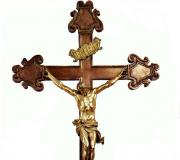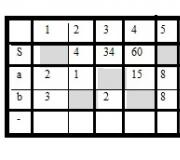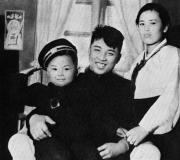All monuments dedicated to the conquest of space. Exhibition "50 years of the monument to the Conquerors of Space" - report
In the north of Moscow, not far from VDNKh, there is Alley of Cosmonauts, an entirely pedestrian street, part of the so-called Cosmopark. The alley was named in 1972 in honor of space heroes, whose busts are installed along the alley. It leads to the monument to the "Conquerors of Space". In 2007-2008, the alley underwent reconstruction and appeared in an updated form.
You can get to the alley by going to the VDNH metro station on the orange line and exiting through the southern exit. Then 2 globes will appear in front of the entrance to the alley. One of them is a globe of the Earth, the other is a globe of the Universe, with a map of the starry sky. 
The alley is laid out in such a way that it is a visual continuation of Mira Avenue for those moving along it from the center of Moscow. As a result, the prospect of a grandiose monument to the “Conquerors of Space” opens up for them from afar. 
From the beginning of the alley and almost to the monument itself, there are pedestals in the form of stars, on which dates with memorable events related to space exploration are affixed. 

A model is installed in the center of the alley solar system, always attracting a lot of children on weekends. 
To the left of the model in 2008, a monument to Sergei Pavlovich Korolev was erected. Its authors are sculptures S.A. Shcherbakov and S.S. Shcherbakov, architects A.V. Kuzmin and I.N. Voskresensky. Originally there was a bust of the Queen on this site. 
Gradually we approach the monument, where we see that some pedestals do not yet have memorial plaques. Apparently a reserve for the future. 
Directly in front of the monuments there is a monument to Konstantin Eduardovich Tsiolkovsky, erected in 1964 (sculptor A.P. Faydysh-Krandievsky). 
Busts of famous cosmonauts erected in 1967 are located next to the monuments. In 2008, they were moved to this place in connection with the reconstruction of the Alley of Cosmonauts; previously they were located a little to the south. 
Bust of Vladimir Mikhailovich Komarov: 
Bust of Alexei Arkhipovich Leonov: 
Bust of Pavel Ivanovich Belyaev: 
Bust of Valentina Vladimirovna Tereshkova: 
Bust of Yuri Alekseevich Gagarin: 
Opposite them is a monument to Valentin Petrovich Glushko: 
And a monument to Mstislav Vsevolodovich Keldysh: 
View from the monument in the opposite direction: 
The Monument to the Conquerors of Space was erected in 1964 to commemorate the achievements of Soviet people in mastering outer space.
The main part of the monument is an obelisk 107 meters high, lined with titanium panels, depicting the trail left behind by a rocket located on top of the obelisk. 


The stylobate of the monument is surrounded by high relief figures of Soviet people - scientists, engineers, workers - whose work made space flights a reality. 
Monument to Tsiolkovsky and the Cosmos Hotel: 
The Cosmos Hotel was built in 1979 and hosted guests Olympic Games in Moscow 1980. 


Also from here you can see the multifunctional residential complex "Tricolor" under construction. 
Main entrance to VDNH: 
Of course, the Ostankino TV tower is visible from all the surrounding areas. 

On April 11, 2009 took place Grand opening The Museum of Cosmonautics after a long reconstruction. We will talk about it some other time. 
More than a hundred-meter titanium stele to the Conquerors of Space - a combination of monumental socialist realism propaganda with abstract art. Having decided to build the monument immediately after the launch of the first satellite, they managed to build it later started manned space flights only in 1964.
The initial preliminary design assumed the current configuration in the form of a rocket on takeoff and its wake, but they wanted to build it out of glass, with internal lighting.
The absurdity of the idea was criticized by a pure techie, secret until his death, Sergei Korolev. This man of genius immediately named the most suitable material– sheet titanium for cladding the frame. He also helped to knock out scarce metal in the Soviet State Planning Committee, and proposed a sound idea to place it in a massive pedestal (stylobate), which was opened for the 20th anniversary of Gagarin’s flight, in 1981.
When discussing the accompanying sculptures of the most distinguished personalities, he categorically protested against his own candidacy. However, untimely death, largely due to trauma from beatings in Stalin's dungeons, overtook the great designer two years after the opening. All his merits, titles and awards became known, and the stele to the Conquerors of Space on its Alley of Cosmonauts found one of the most worthy of this title.
Placement and appearance
Initially, they planned to erect a record-breaking monument for Moscow near the Moscow State University building on Vorobyovy Gory, then still Lenin Hills. But the decision to double the height from 50 meters forced us to look for a new location so as not to upset the existing altitude balance. The then empty area near VDNKh was quite suitable for this; now it’s hard to believe that the stele to the Conquerors of Space could have ended up in another area.
To clearly show our readers the spatial placement of the monument, we had to use a flying assistant. The quadcopter not only took a photo, but also filmed it, which is even more eloquent. In the photo, the stele to the Conquerors of Space rises above the surrounding area as an excellent landmark; it is not without aesthetic appeal. There is no heaviness predicted by skeptics.
From the park area, the stele to the Conquerors of Space looks no less impressive than from above. To imagine the takeoff of a real rocket while looking at the monument does not require a heightened imagination. Titanium does not fade over time, the metal practically does not oxidize, reflects Sun rays. A ten-meter rocket raised to a height of 100 meters looks small from the surface.

From the walking paths the rocket and the conventional plume of gases are clearly visible; gentle slopes with lawns additionally decorate the imaginary cosmodrome. The surrounding area is a beautiful oasis of vegetation among noisy city. Larch trees of considerable age, which are not very common in central Russia, are the main decoration of the local landscape.
Emerging associations
From the north side, the stele to the Conquerors of Space looks like a continuation of the sloping roof of the Museum of Cosmonautics, created and placed on a pedestal according to the design of the Chief Designer of ballistic missiles. Twenty years of Korolev’s work in this position made the USSR one of the leaders in world cosmonautics. His unexpected death interrupted his activities, preventing him from completing the lunar program.

A single designer of the monument and the museum building as its integral part ensured the inextricable unity of the entire complex. The wave of the museum's roof looks like a cooling stream of gases from a rocket plume spreading across the surface of the Earth. The building is framed by granite stairs leading to the bas-reliefs on the pedestal of the monument.
From the opposite, southern part, the stele to the Conquerors of Space looks like the fin of a colossal shark. Another emerging association is the bow of a sailboat, with the figure of Tsiolkovsky instead of the caryatids of ancient ships. The adjacent square and the Alley of Heroes with monuments to cosmonauts are like the surface of the sea in front of a sailing ship.

The monument to Konstantin Eduardovich Tsiolkovsky was made by one of the creators of the stele, and they were opened at the same time. The inscription on the rectangular pedestal is extremely laconic, containing only the name and the words - founder of astronautics. Surprisingly, the space flight theorist, who mastered the most complex calculations, was self-taught, a provincial school teacher.
The founder of astronautics is depicted by the sculptor seated, with his gaze directed to the heavens. However, he was not the out-of-touch dreamer he is often portrayed as. Tsiolkovsky substantiated the use of the principle of jet propulsion for rocket vehicles, calculated flight orbits to the nearest celestial bodies. The theory of supersonic movement in the stratosphere, calculations of flights of variable mass rockets are also his developments.

The design of the airship he developed was examined by the most prominent scientists, the first wind tunnel found practical use. Much later than the justification and calculations of Tsiolkovsky, but largely thanks to them, orbital space station. It is they who have now become the main component of the study and development of near-Earth space.
Heroes of space takeoffs
The end part of the pedestal, from which the stele to the Conquerors of Space rises upward, contains poetic and official praises of our successes in the conquest of space. Although well deserved, these words are read today with a fair amount of sadness. Russia lost both the race to the Moon and the use of ships reusable, and it’s not the heroes of space who are to blame for this.

The side surfaces of the pedestal are decorated with bas-reliefs, picturesquely describing the contribution of all those involved in the exploration of outer space. Here you can see an astronaut climbing the steps, and scientists creating means of transportation in space. Factory workers who translate developments and drawings into concrete products are not forgotten either.
Designed in a similar way west side pedestal. Both bas-reliefs abound not only with figures of heroes and workers, but also with many elements of Soviet symbolism. flying spaceships and working drawings - next to banners and emblems, the inevitable Lenin and a child in the arms of a woman.

I didn’t want to say anything negative about this truly outstanding monument. However, against the backdrop of current reality, the pathos and propaganda of that time seem clumsy and pompous. This is not the fault of those who created the stele to the Conquerors of Space, much less the heroes of the monument themselves. This was the dominant ideology and practice, which smoothly led the most powerful power into a dead end.
Do not accuse the observer of hopeless pessimism; faith in a bright future is not empty words, although it can be expressed more simply. Our current reality is far from ideal, but life requires improvement and forward movement. With its slender silhouette, the stele seems to support space explorers in a positive mood and help overcome negative thoughts.

The story about a monument created in the irretrievably gone past is not nostalgia, but thoughts about the future. The Stele to the Space Conquerors with a soaring rocket seems to be calling on them not to rest on their laurels and always strive for new achievements.



31.12.2018
2018 ends, the year of the yellow dog and 2019 begins yellow pig. A playful and cheerful dog hands over the reins to a well-fed and calm pig.
31.12.2017
Dear friends, on the last day of the 2017 year of the fiery rooster, we want to congratulate you on the advent of the New Year 2018, the year of the yellow dog.
31.12.2016
In the coming new year 2017, we wish that fire rooster brought you good luck, happiness and bright and positive impressions during your travels.
31.12.2015
On the last day of the passing year, we want to congratulate you on the advent of 2016, the year of energetic and cheerful monkey.
16.10.2015
On October 16, 2015, the monument was stolen People's Artist Soviet Union Evgeny Leonov.
A country: Russia
City: Moscow
Nearest metro: VDNH
Was passed: 1964
Sculptor: Andrey Faydysh-Krandievsky
Architect: Alexander Kolchin, Mikhail Barshch
Description
The 107-meter-high monument represents a rocket soaring into the sky, leaving behind a trail of exhaust gases from its engines. At the base of the monument, Yuri Gagarin is depicted climbing the steps to conquer space. Behind him are people whose work made these steps possible. On the base of the monument there are lines Soviet writer Nikolai Gribachev.
“...And our efforts were rewarded,
What, having overcome lawlessness and darkness,
We forged fiery wings
To your country and your age!”
And below is the inscription “This monument was built in 1964 to commemorate the outstanding achievements of the Soviet people in space exploration.”. As well as the date of the world’s first successful launch of an artificial earth satellite and the date of the first human flight into space. Under the base of the monument there is a cosmonautics museum. And in front of the monument there is a monument to the founder of modern cosmonautics, Soviet scientist Konstantin Eduardovich Tsiolkovsky.
History of creation
It was decided to erect the monument immediately after the successful launch of an artificial earth satellite. In 1958, a competition was announced for best project. And on the seven-year anniversary of the launch of Sputnik in 1964, the Monument to the Conquerors of Space was inaugurated.
- Date of construction: 1964
- Architect, sculptor, restorer: Sculptor A.P. Faydysh-Krandievsky, architects M.O. Barshch, A.N. Kolchin
- Address: Prospekt Mira, no. 124. Alley of Cosmonauts
- Metro: VDNH
- Coordinates: 37°38′23.14″E; 55°49′20.79″N
October 4, 1964 on the seventh anniversary of the launch of the first satellite, on Mira Avenue, a grandiose architectural and sculptural complex-monument was inaugurated, the main part of which has the shape of an obelisk, as if composed of a bunch of parabolas, lined with sheet titanium and crowned with a silver 11-meter model space rocket. The total height of the monument including the rocket reaches 107 meters. The authors of the monument are sculptor A.P. Faydysh - Krandievsky, architects M.O. Barshch, A.N. Kolchin, engineers L.N. Shchipakin, V.N. Laptev. The tall monument is the dominant feature of the area. The Alley of Heroes leads to the obelisk, consisting of monuments to cosmonauts and explorers: Gagarin, Keldysh, etc.
Flight into space, without exaggeration, can be called one of the most grandiose and significant events of the 20th century. The idea of creating a monument appeared immediately after the launch of the first artificial Earth satellite. For the best sculptural composition An all-Union competition was announced on this topic. Out of more than three hundred projects, this was the winner. And, I must say, not in vain. The monument, despite its monumentality, looks harmonious: there is no feeling of bulkiness or heaviness. The swiftness of the take-off, heralding the opening of the era of space exploration, is perfectly conveyed. Simplicity and elegance of form, a plus good quality execution makes the monument a very “stylish little thing” - ready business card or the logo of any space industry enterprise.
The base of the monument is decorated with bas-reliefs depicting engineers, scientists, workers - everyone who worked to realize the idea of human space exploration. In front of the monument is a statue of the founder of Russian cosmonautics, Konstantin Eduardovich Tsiolkovsky. His inspired look seems to foreshadow the transformation of the idea of space flight into reality. During Tsiolkovsky's lifetime, space exploration was the most popular topic fantasy stories, which, by the way, were also written by the scientist himself. Few people believed that such incredible flights would become possible in the near future. Tsiolkovsky did not live to see this solemn moment for only a little over twenty years. The launch of the first Earth satellite, the flight of Belka and Strelka, and, finally, the first human space flight, so, once upon a time, book fiction became a reality. And yet these are only the first steps into the vast outer space - alluring, mysterious, unknown...
In the stylobate of the monument there is a Museum of Cosmonautics and science Library. Museum visitors can communicate directly with the astronauts, test themselves on space simulators and taste the “exotic dishes” of space cuisine - tubes with various foods.
In March 1958, just a couple of months after the successful launch of the Soviet artificial satellite into Earth orbit, the country announced a competition to create a monument to space explorers to commemorate the beginning of the era of exploration of the Universe.
Initially, it was planned to erect a monument on Sparrow Hills - in front of the main building of Moscow State University.
Photo 1. Monument to space explorers in Moscow near VDNKh
In the first ten days of May of the same code, about 1000 projects from more than 110 cities of the Soviet Union, and even from foreign countries. The selected 365 of them were put on public display in the Manege.
The first prize was awarded project by architects Alexander Nikolaevich Kolchin and Mikhail Osipovich Barshch “The Creator People”. Engineer Lev Nikolaevich Shchipakin and sculptor Andrei Petrovich Faydysh-Krandievsky worked together with them. It is interesting that the first three winning projects, one way or another, played on the theme of a rocket launch.
The choice of the above-mentioned project required a revision of the site for the construction of a monument to space explorers, since its installation near the Moscow State University building brought dissonance to architectural appearance this territory of Moscow. And then it was proposed to build it not far from the main entrance of VDNH.

It is worth noting that the peculiar design and original solution The appearance of the monument to space explorers required additional engineering calculations and additions to the engineering part of the project. This task was successfully completed at the Research Institute of Construction Metal Structures named after N.P. Melnikov, where the work was led by Vladimir Nikolaevich Laptev.
Celebrations to mark the opening of the monument in honor of space explorers took place on October 4, 1964, the day of the seventh anniversary of the launch of the first artificial satellite of the planet Earth.

Architecture and history of the monument to space explorers
The majestic and grandiose monument to space explorers in to a greater extent created in the format of an obelisk, as if assembled from a bunch of parabolas. They covered it with sheets of eternal titanium, and on top they installed a model of a rocket, the length of which is about 11 meters. The monument itself, from the base to the nose of the rocket ship, soared into the skies to a height of 107 meters.
It is worth noting that, despite its grandeur, the monument to space explorers looks very harmonious: there is no feeling of heaviness or clutter. The authors were perfectly able to interpret the swiftness of the rocket launch - a harbinger of the beginning space age in the history of Humanity.
Thanks to its simplicity and elegant forms, as well as its recognition, this monument has become the logo of many space-oriented institutions.


Foundation of the monument to space explorers in Moscow, it is decorated with bas-reliefs, which depict images of everyone who contributed to the exploration of outer space: scientists, engineers, cosmonauts and workers.
In front of the stele, over time, a monument to Konstantin Eduardovich Tsiolkovsky, the founder of our domestic cosmonautics, was erected. It was thanks to his vision and ideas that space flights became a reality, and his followers brought the dream to life.

The monument to space explorers at VDNKh has become the dominant feature of the surrounding area of Moscow. Next to it, on the side of Mira Avenue, over time they created the Alley of Cosmonauts, where their busts and busts of scientists were installed. In the recent past, a monument to Sergei Pavlovich Korolev and a site-model of the Solar System appeared here.
Did you like the material? It's easy to say thank you! We would be very grateful if you could share this article on in social networks. And if you have have something to add on the topic, please write in the comments. Thank you!
New articles on the site:
Interesting blog:




